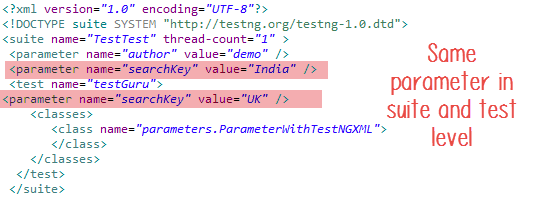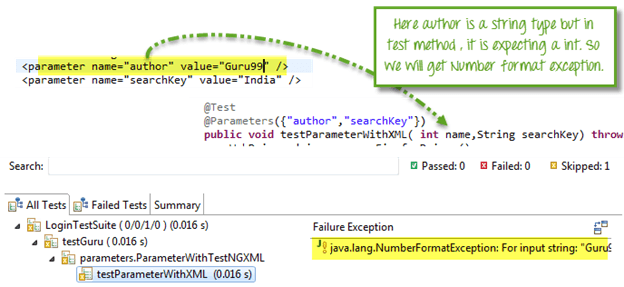Proveedor de datos & TestNG XML: Parametrización en Selenium(Ejemplo)
Parametrización en Selenium
Parametrización en Selenium es un proceso para parametrizar los scripts de prueba para pasar múltiples datos a la aplicación en tiempo de ejecución. Es una estrategia de ejecución que ejecuta automáticamente casos de prueba varias veces utilizando diferentes valores. El concepto logrado al parametrizar los scripts de prueba se llama Pruebas basadas en datos.
Tipo de Parametrización en TestNG-
Para que la parametrización sea más clara, repasaremos las opciones de parametrización en uno de los marcos más populares para Selenium controlador web – TestNG.
Hay dos maneras mediante el cual podemos lograr la parametrización en TestNG
Los parámetros de Testng.xml pueden ser de nivel de suite o de prueba
El parámetro de DataProvider puede tomar Method e ITestContext como parámetro.
Estudiémoslos en detalle –
Anotación de parámetros en TestNG
Anotación de parámetros en TestNG es un método utilizado para pasar valores a los métodos de prueba como argumentos utilizando un archivo .xml. Es posible que se solicite a los usuarios que pasen los valores a los métodos de prueba durante el tiempo de ejecución. El método de anotación @Parameters se puede utilizar en cualquier método que tenga la anotación @Test, @Before, @After o @Factory.
Anotación de parámetros con Testng.xml
Seleccione la parametrización mediante anotaciones cuando desee lidiar con la complejidad y el número de combinaciones de entrada sea menor.
Veamos cómo funciona esto.
Escenario de prueba
Paso 1) Inicie el navegador y vaya a Google.com
Paso 2) Ingrese una palabra clave de búsqueda
Paso 3) Verifique que el valor ingresado sea el mismo que el proporcionado por nuestros datos de prueba
Paso 4) Repita 2 y 3 hasta ingresar todos los valores
| Autor de la prueba | Clave de búsqueda |
|---|---|
| Guru99 | India |
| Krishna | USA |
| Bhupesh | China |
Aquí un ejemplo de cómo hacerlo SIN parámetros
package parameters;
import org.testng.annotations.Test;
import org.testng.AssertJUnit;
import java.util.concurrent.TimeUnit;
import org.openqa.selenium.By;
import org.openqa.selenium.WebDriver;
import org.openqa.selenium.WebElement;
import org.openqa.selenium.firefox.FirefoxDriver;
public class NoParameterWithTestNGXML {
String driverPath = "C:\\geckodriver.exe";
WebDriver driver;
@Test
public void testNoParameter() throws InterruptedException{
String author = "guru99";
String searchKey = "india";
System.setProperty("webdriver.gecko.driver", driverPath);
driver= new FirefoxDriver();
driver.manage().timeouts().implicitlyWait(10, TimeUnit.SECONDS);
driver.get("https://google.com");
WebElement searchText = driver.findElement(By.name("q"));
//Searching text in google text box
searchText.sendKeys(searchKey);
System.out.println("Welcome ->"+author+" Your search key is->"+searchKey);
System.out.println("Thread will sleep now");
Thread.sleep(3000);
System.out.println("Value in Google Search Box = "+searchText.getAttribute("value") +" ::: Value given by input = "+searchKey);
//verifying the value in google search box
AssertJUnit.assertTrue(searchText.getAttribute("value").equalsIgnoreCase(searchKey));
}
}
Un estudio del ejemplo anterior. Imagínese lo complejo que será el código cuando hagamos esto para tres combinaciones de entrada.
Ahora, parametricemos esto usando TestNG
Para hacerlo, necesitarás
- Cree un archivo XML que almacenará los parámetros.
-
En la prueba, agregue la anotación @Parameters
Aquí está el código completo
Nivel de prueba TestNG.xml
<?xml version="1.0" encoding="UTF-8"?> <!DOCTYPE suite SYSTEM "http://testng.org/testng-1.0.dtd"> <suite name="TestSuite" thread-count="3" > <parameter name="author" value="Guru99" /> <parameter name="searchKey" value="India" /> <test name="testGuru"> <parameter name="searchKey" value="UK" /> <classes> <class name="parameters.ParameterWithTestNGXML"> </class> </classes> </test> </suite>
ParámetroConTestNGArchivo XML.java
package parameters;
import org.testng.AssertJUnit;
import java.util.concurrent.TimeUnit;
import org.openqa.selenium.By;
import org.openqa.selenium.WebDriver;
import org.openqa.selenium.WebElement;
import org.openqa.selenium.firefox.FirefoxDriver;
import org.testng.annotations.Optional;
import org.testng.annotations.Parameters;
import org.testng.annotations.Test;
public class ParameterWithTestNGXML {
String driverPath = "C:\\geckodriver.exe";
WebDriver driver;
@Test
@Parameters({"author","searchKey"})
public void testParameterWithXML( @Optional("Abc") String author,String searchKey) throws InterruptedException{
System.setProperty("webdriver.gecko.driver", driverPath);
driver = new FirefoxDriver();
driver.manage().timeouts().implicitlyWait(10, TimeUnit.SECONDS);
driver.get("https://google.com");
WebElement searchText = driver.findElement(By.name("q"));
//Searching text in google text box
searchText.sendKeys(searchKey);
System.out.println("Welcome ->"+author+" Your search key is->"+searchKey);
System.out.println("Thread will sleep now");
Thread.sleep(3000);
System.out.println("Value in Google Search Box = "+searchText.getAttribute("value") +" ::: Value given by input = "+searchKey);
//verifying the value in google search box
AssertJUnit.assertTrue(searchText.getAttribute("value").equalsIgnoreCase(searchKey));
}
}
Instrucciones para ejecutar el script, seleccionar el archivo XML y ejecutar como Test NG Suite
Haga clic derecho en el archivo .xml -> Ejecutar como -> Prueba Suite (Nota: Suite)
Ahora, los parámetros se pueden definir en 2 niveles.
- Nivel de suite: los parámetros dentro del etiqueta de TestNG El archivo XML será un parámetro de nivel de suite.
- Nivel de prueba: los parámetros dentro de la etiqueta del archivo XML de prueba serán un parámetro de nivel de prueba.
Aquí está la misma prueba con parámetros de nivel suite.
NOTA: En caso de que el nombre del parámetro sea el mismo en el nivel de suite y en el nivel de prueba, el parámetro del nivel de prueba tendrá preferencia sobre el nivel de suite. Entonces, en ese caso, todas las clases dentro de ese nivel de prueba compartirán el parámetro anulado, y otras clases que están fuera del nivel de prueba compartirán el parámetro de nivel de suite.
Localización de averías
Número 1 El valor del parámetro en testng.xml no se puede convertir al parámetro del método de prueba correspondiente, ya que generará un error.
Consideremos el siguiente ejemplo
Aquí, el atributo "autor" es igual a "Guru99", que es una cadena y en el método de prueba correspondiente se espera un valor entero, por lo que obtendremos una excepción aquí.
Número 2 Sus @Parameters no tienen un valor correspondiente en testing.xml.
Puedes resolver esta situación agregando @Opcional anotación en el parámetro correspondiente en el método de prueba.
Problema n. ° 3: Desea probar múltiples valores del mismo parámetro usando Testng.xml
¡La respuesta simple es que esto no se puede hacer! Puede tener varios parámetros diferentes, pero cada parámetro solo puede tener un valor único. Esto ayuda a evitar codificar valores en el script. Esto hace que el código sea reutilizable. Piense en ello como archivos de configuración para su secuencia de comandos. Si desea utilizar varios valores para un parámetro, utilice DataProviders
Proveedor de datos en TestNG
Proveedor de datos en TestNG es un método que se utiliza cuando un usuario necesita pasar parámetros complejos. Los parámetros complejos deben crearse a partir de Java Por ejemplo, se pueden pasar objetos complejos, objetos de archivos de propiedades o de una base de datos mediante el método del proveedor de datos. El método está anotado con @DataProvider y devuelve una matriz de objetos.
Parámetros usando el proveedor de datos
La anotación @Parameters es fácil, pero para probar con múltiples conjuntos de datos necesitamos usar el proveedor de datos.
Para completar miles de formularios web utilizando nuestro marco de prueba, necesitamos una metodología diferente que pueda brindarnos un conjunto de datos muy grande en un solo flujo de ejecución.
Este concepto basado en datos se logra mediante @Proveedor de datos anotación en TestNG.
tiene solo uno Nombre del Atributo'. Si no especifica el atributo de nombre, el nombre del proveedor de datos será el mismo que el nombre del método correspondiente.
Devoluciones del proveedor de datos un objeto JAVA bidimensional al método de prueba y al método de prueba, invocará M veces en una matriz de objetos de tipo M*N. Por ejemplo, si DataProvider devuelve una matriz de 2*3 objetos, el caso de prueba correspondiente se invocará 2 veces con 3 parámetros cada vez.
Ejemplo completo
package parameters;
import java.util.concurrent.TimeUnit;
import org.openqa.selenium.By;
import org.openqa.selenium.WebDriver;
import org.openqa.selenium.WebElement;
import org.openqa.selenium.firefox.FirefoxDriver;
import org.testng.Assert;
import org.testng.annotations.BeforeTest;
import org.testng.annotations.DataProvider;
import org.testng.annotations.Test;
public class ParameterByDataprovider {
WebDriver driver;
String driverPath = "C:\\geckodriver.exe";
@BeforeTest
public void setup(){
//Create firefox driver object
System.setProperty("webdriver.gecko.driver", driverPath);
driver = new FirefoxDriver();
driver.manage().timeouts().implicitlyWait(10, TimeUnit.SECONDS);
driver.get("https://google.com");
}
/** Test case to verify google search box
* @param author
* @param searchKey
* @throws InterruptedException
*/
@Test(dataProvider="SearchProvider")
public void testMethod(String author,String searchKey) throws InterruptedException{
{
WebElement searchText = driver.findElement(By.name("q"));
//search value in google searchbox
searchText.sendKeys(searchKey);
System.out.println("Welcome ->"+author+" Your search key is->"+searchKey);
Thread.sleep(3000);
String testValue = searchText.getAttribute("value");
System.out.println(testValue +"::::"+searchKey);
searchText.clear();
//Verify if the value in google search box is correct
Assert.assertTrue(testValue.equalsIgnoreCase(searchKey));
}
}
/**
* @return Object[][] where first column contains 'author'
* and second column contains 'searchKey'
*/
@DataProvider(name="SearchProvider")
public Object[][] getDataFromDataprovider(){
return new Object[][]
{
{ "Guru99", "India" },
{ "Krishna", "UK" },
{ "Bhupesh", "USA" }
};
}
}
Invocar DataProvider desde una clase diferente
De forma predeterminada, DataProvider reside en la misma clase donde está el método de prueba o su clase base. Para ponerlo en alguna otra clase necesitamos hacer que el método del proveedor de datos sea estático y en el método de prueba necesitamos agregar un atributo. clase de proveedor de datos in @Prueba anotación.
Ejemplo de código
Parámetro TestClassProviderWithClassLevel.java
package parameters;
import java.util.concurrent.TimeUnit;
import org.openqa.selenium.By;
import org.openqa.selenium.WebDriver;
import org.openqa.selenium.WebElement;
import org.openqa.selenium.firefox.FirefoxDriver;
import org.testng.Assert;
import org.testng.annotations.BeforeTest;
import org.testng.annotations.Test;
public class ParameterDataproviderWithClassLevel {
WebDriver driver;
String driverPath = "C:\\geckodriver.exe";
@BeforeTest
public void setup(){
System.setProperty("webdriver.gecko.driver", driverPath);
driver = new FirefoxDriver();
driver.manage().timeouts().implicitlyWait(10, TimeUnit.SECONDS);
driver.get("https://google.com");
}
@Test(dataProvider="SearchProvider",dataProviderClass=DataproviderClass.class)
public void testMethod(String author,String searchKey) throws InterruptedException{
WebElement searchText = driver.findElement(By.name("q"));
//Search text in google text box
searchText.sendKeys(searchKey);
System.out.println("Welcome ->"+author+" Your search key is->"+searchKey);
Thread.sleep(3000);
//get text from search box
String testValue = searchText.getAttribute("value");
System.out.println(testValue +"::::"+searchKey);
searchText.clear();
//verify if search box has correct value
Assert.assertTrue(testValue.equalsIgnoreCase(searchKey));
}
}
Proveedor de datosClass.java
package parameters;
import org.testng.annotations.DataProvider;
public class DataproviderClass {
@DataProvider(name="SearchProvider")
public static Object[][] getDataFromDataprovider(){
return new Object[][] {
{ "Guru99", "India" },
{ "Krishna", "UK" },
{ "Bhupesh", "USA" }
};
}}
Tipos de parámetros en el proveedor de datos
Hay dos tipos de parámetros admitidos por el método DataProvider.
Método- Si el MISMO DataProvider debe comportarse de manera diferente con diferentes métodos de prueba; use el parámetro Método.
En el siguiente ejemplo,
- Comprobamos si el nombre del método es testMethodA.
- En caso afirmativo, devuelva un conjunto de valores.
- De lo contrario, devolverá otro conjunto de valores.
package parameters;
import java.lang.reflect.Method;
import java.util.concurrent.TimeUnit;
import org.openqa.selenium.By;
import org.openqa.selenium.WebDriver;
import org.openqa.selenium.WebElement;
import org.openqa.selenium.firefox.FirefoxDriver;
import org.testng.Assert;
import org.testng.annotations.BeforeTest;
import org.testng.annotations.DataProvider;
import org.testng.annotations.Test;
public class ParameterByMethodInDataprovider{
WebDriver driver;
String driverPath = "C:\\geckodriver.exe";
@BeforeTest
public void setup(){
System.setProperty("webdriver.gecko.driver", driverPath);
driver = new FirefoxDriver();
driver.manage().timeouts().implicitlyWait(10, TimeUnit.SECONDS);
driver.get("https://google.com");
}
@Test(dataProvider="SearchProvider")
public void testMethodA(String author,String searchKey) throws InterruptedException{
WebElement searchText = driver.findElement(By.name("q"));
//Search text in search box
searchText.sendKeys(searchKey);
//Print author and search string
System.out.println("Welcome ->"+author+" Your search key is->"+searchKey);
Thread.sleep(3000);
String testValue = searchText.getAttribute("value");
System.out.println(testValue +"::::"+searchKey);
searchText.clear();
//Verify if google text box is showing correct value
Assert.assertTrue(testValue.equalsIgnoreCase(searchKey));
}
@Test(dataProvider="SearchProvider")
public void testMethodB(String searchKey) throws InterruptedException{
{
WebElement searchText = driver.findElement(By.name("q"));
//Search text in search box
searchText.sendKeys(searchKey);
//Print only search string
System.out.println("Welcome ->Unknown user Your search key is->"+searchKey);
Thread.sleep(3000);
String testValue = searchText.getAttribute("value");
System.out.println(testValue +"::::"+searchKey);
searchText.clear();
//Verify if google text box is showing correct value
Assert.assertTrue(testValue.equalsIgnoreCase(searchKey));
}
}
/**
* Here DataProvider returning value on the basis of test method name
* @param m
* @return
**/
@DataProvider(name="SearchProvider")
public Object[][] getDataFromDataprovider(Method m){
if(m.getName().equalsIgnoreCase("testMethodA")){
return new Object[][] {
{ "Guru99", "India" },
{ "Krishna", "UK" },
{ "Bhupesh", "USA" }
};}
else{
return new Object[][] {
{ "Canada" },
{ "Russia" },
{ "Japan" }
};}
}
}
Aquí está la salida
Contexto de prueba de TI– Se puede utilizar para crear diferentes parámetros para casos de prueba basados en grupos.
En la vida real, puede utilizar ITestContext para variar los valores de los parámetros según los métodos de prueba, los hosts y las configuraciones de la prueba.
En el siguiente ejemplo de código
- Tenemos 2 grupos A y B
- Cada método de prueba se asigna a un grupo.
- Si el valor del grupo es A, se devuelve un conjunto de datos particular
- Si el valor del grupo es B, se devuelve otro conjunto de datos.
package parameters;
import java.util.concurrent.TimeUnit;
import org.openqa.selenium.By;
import org.openqa.selenium.WebDriver;
import org.openqa.selenium.WebElement;
import org.openqa.selenium.firefox.FirefoxDriver;
import org.testng.Assert;
import org.testng.ITestContext;
import org.testng.annotations.BeforeTest;
import org.testng.annotations.DataProvider;
import org.testng.annotations.Test;
public class ParameterByITestContextInDataprovider {
WebDriver driver;
String driverPath = "C:\\geckodriver.exe";
@BeforeTest(groups={"A","B"})
public void setup(){
System.setProperty("webdriver.gecko.driver", driverPath);
driver = new FirefoxDriver();
driver.manage().timeouts().implicitlyWait(10, TimeUnit.SECONDS);
driver.get("https://google.com");
}
@Test(dataProvider="SearchProvider",groups="A")
public void testMethodA(String author,String searchKey) throws InterruptedException{
{
//search google textbox
WebElement searchText = driver.findElement(By.name("q"));
//search a value on it
searchText.sendKeys(searchKey);
System.out.println("Welcome ->"+author+" Your search key is->"+searchKey);
Thread.sleep(3000);
String testValue = searchText.getAttribute("value");
System.out.println(testValue +"::::"+searchKey);
searchText.clear();
//verify correct value in searchbox
Assert.assertTrue(testValue.equalsIgnoreCase(searchKey));
}
}
@Test(dataProvider="SearchProvider",groups="B")
public void testMethodB(String searchKey) throws InterruptedException{
{
//find google search box
WebElement searchText = driver.findElement(By.name("q"));
//search a value on it
searchText.sendKeys(searchKey);
System.out.println("Welcome ->Unknown user Your search key is->"+searchKey);
Thread.sleep(3000);
String testValue = searchText.getAttribute("value");
System.out.println(testValue +"::::"+searchKey);
searchText.clear();
//verify correct value in searchbox
Assert.assertTrue(testValue.equalsIgnoreCase(searchKey));
}
}
/**
* Here the DAtaProvider will provide Object array on the basis on ITestContext
* @param c
* @return
*/
@DataProvider(name="SearchProvider")
public Object[][] getDataFromDataprovider(ITestContext c){
Object[][] groupArray = null;
for (String group : c.getIncludedGroups()) {
if(group.equalsIgnoreCase("A")){
groupArray = new Object[][] {
{ "Guru99", "India" },
{ "Krishna", "UK" },
{ "Bhupesh", "USA" }
};
break;
}
else if(group.equalsIgnoreCase("B"))
{
groupArray = new Object[][] {
{ "Canada" },
{ "Russia" },
{ "Japan" }
};
}
break;
}
return groupArray;
}
}
Nota: Si ejecuta directamente su clase testng, primero llamará a dataprovider, que no puede obtener información de los grupos, ya que estos no están disponibles. Pero, en cambio, si llama a esta clase a través de testng.xml, tendrá información de los grupos disponible con ITestContext. Use el siguiente XML para llamar a la clase testng.
<!DOCTYPE suite SYSTEM "http://beust.com/testng/testng-1.0.dtd" >
<suite name="test-parameter">
<test name="example1">
<groups>
<run>
<include name="A" />
</run>
</groups>
<classes>
<class
name="parameters.ParameterByITestContextInDataprovider" />
</classes>
</test>
<test name="example2">
<groups>
<run>
<include name="B" />
</run>
</groups>
<classes>
<class
name="parameters.ParameterByITestContextInDataprovider" />
</classes>
</test>
</suite>
Resumen
- Parametrización es necesario crear Pruebas basadas en datos.
- TestNG admite dos tipos de parametrización, utilizando @Parámetro+TestNG.xml y utilizando@Proveedor de datos
-
In @Parámetro+TestNG.xml Los parámetros se pueden colocar en el nivel de suite y en el nivel de prueba. Si
El mismo nombre de parámetro se declara en ambos lugares; El parámetro de nivel de prueba tendrá preferencia sobre el parámetro de nivel de traje.
- usando @Parámetro+TestNG.xml solo se puede establecer un valor a la vez, pero @DataProvider devuelve una matriz 2d de objeto.
- Si DataProvider está presente en una clase diferente, entonces la clase donde reside el método de prueba,Proveedor de datos debiera ser método estático.
- Hay dos parámetros soportados por Proveedor de datos están Método y Contexto de prueba.
















